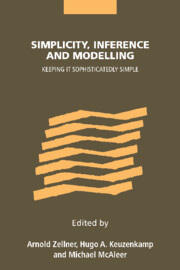Book contents
- Frontmatter
- Contents
- List of figures
- List of tables
- List of contributors
- 1 The enigma of simplicity
- PART I The importance of simplicity
- PART II Simplicity in theory and practice
- 8 Simplicity, information, Kolmogorov complexity and prediction
- 9 Simplicity and statistical inference
- 10 Rissanen's theorem and econometric time series
- 11 Parametric versus non-parametric inference: statistical models and simplicity
- 12 The role of simplicity in an econometric model selection process
- 13 Simplicity in a behavioural, non-parametric context
- 14 Keep it sophisticatedly simple
- 15 Communication, complexity and coordination in games
- 16 The simplicity of an earnings frontier
- 17 Simplicity: views of some Nobel laureates in economic science
- Index
14 - Keep it sophisticatedly simple
Published online by Cambridge University Press: 22 September 2009
- Frontmatter
- Contents
- List of figures
- List of tables
- List of contributors
- 1 The enigma of simplicity
- PART I The importance of simplicity
- PART II Simplicity in theory and practice
- 8 Simplicity, information, Kolmogorov complexity and prediction
- 9 Simplicity and statistical inference
- 10 Rissanen's theorem and econometric time series
- 11 Parametric versus non-parametric inference: statistical models and simplicity
- 12 The role of simplicity in an econometric model selection process
- 13 Simplicity in a behavioural, non-parametric context
- 14 Keep it sophisticatedly simple
- 15 Communication, complexity and coordination in games
- 16 The simplicity of an earnings frontier
- 17 Simplicity: views of some Nobel laureates in economic science
- Index
Summary
Introduction
Some years ago, I came upon the phrase used in industry, ‘Keep it simple stupid’, that is, KISS, and thought about it in relation to scientific model-building. Since some simple models are stupid, I decided to reinterpret KISS to mean ‘Keep it sophisticatedly simple.’ In any event, KISS is very popular in many scientific and non-scientific areas. For example, the slogan of the Honda Motor Company is, ‘We make it simple.’ The Dutch Schipol airport in its advertising claims that, ‘It excels because it is simple and convenient.’ And it is well known that Einstein advised in connection with theorizing in the natural sciences, ‘Make it as simple as possible but no simpler.’ Also, the famous physicist Jaynes (1985, p. 344) wrote, ‘We keep our model as simple as possible so as not to obscure the point to be made and also to heed Arnold Zellner's wise advice about “sophisticatedly simple” models.’
Many, including myself, have for long advocated that workers in econometrics and statistics follow the advice of natural scientists and others to keep analyses and models sophisticatedly simple. In addition, I have pointed out that there are many important, sophisticatedly simple models and methods that work well in practice, that is in explanation and prediction, namely s = ½ gt2, E = mc2, PV = RT, maxent, etc.
- Type
- Chapter
- Information
- Simplicity, Inference and ModellingKeeping it Sophisticatedly Simple, pp. 242 - 262Publisher: Cambridge University PressPrint publication year: 2002
- 14
- Cited by



